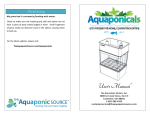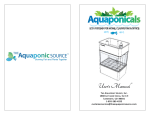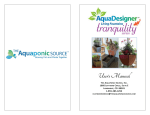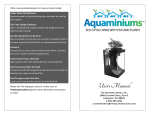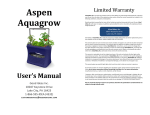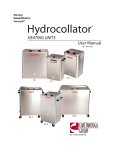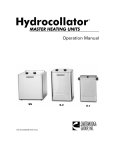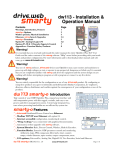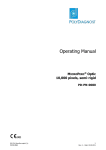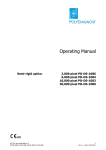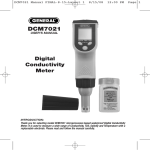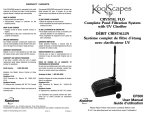Download here`s - The Aquaponic Source
Transcript
Peak Performance Pack T HE A QUAPONIC S OURCE , I NC . 1860 L EFTHAND C IRCLE , S UITE E L ONGMONT , CO 80501 1‐855‐285‐4252 CUSTOMERSERVICE @ THEAQUAPONICSOURCE . COM Table of Contents Table of Contents ................................................................. 1 What’s Included ................................................................... 2 Background .......................................................................... 3 Understanding Aquaponics Plant Nutrition .......................... 3 pH Over the Life of Your AquaDesigner System ................... 5 The Role of Carbonate Hardness (KH) in pH Management .. 6 Raising pH in Aquaponics ...................................................... 8 Iron Deficiency ...................................................................... 8 A Word of Caution ................................................................ 9 Instructions ........................................................................ 10 Step 1: Test ......................................................................... 10 Step 2: Adjust ..................................................................... 11 Refills ................................................................................. 13 Other Recommended Products .......................................... 14 Questions / Support ........................................................... 16 NOTES ___________________________________________________ ___________________________________________________ ___________________________________________________ ___________________________________________________ ___________________________________________________ ___________________________________________________ ___________________________________________________ ___________________________________________________ ___________________________________________________ ___________________________________________________ ___________________________________________________ ___________________________________________________ ___________________________________________________ ___________________________________________________ ___________________________________________________ ___________________________________________________ ___________________________________________________ ___________________________________________________ ___________________________________________________ ___________________________________________________ ___________________________________________________ ___________________________________________________ ___________________________________________________ ___________________________________________________ ___________________________________________________ ___________________________________________________ ___________________________________________________ ___________________________________________________ ___________________________________________________ ___________________________________________________ © Copyright 2014 The Aquaponic Source, Inc. Page 18 of 18 NOTES What’s Included ___________________________________________________ ___________________________________________________ ___________________________________________________ ___________________________________________________ ___________________________________________________ ___________________________________________________ ___________________________________________________ ___________________________________________________ ___________________________________________________ ___________________________________________________ ___________________________________________________ ___________________________________________________ ___________________________________________________ ___________________________________________________ ___________________________________________________ ___________________________________________________ ___________________________________________________ ___________________________________________________ ___________________________________________________ ___________________________________________________ ___________________________________________________ ___________________________________________________ ___________________________________________________ ___________________________________________________ ___________________________________________________ ___________________________________________________ Your AquaDesigner Peak Performance Pack includes the following: © Copyright 2014 The Aquaponic Source, Inc. © Copyright 2014 The Aquaponic Source, Inc. Page 17 of 18 Page 2 of 18 API pH Test Kit API KH Carbonate Hardness Test Kit AquaUp o ½ lb Potassium Carbonate o ½ lb Calcium Carbonate AquaIron – ¼ lb AquaBuffer – ½ lb Transfer pipette Background Questions / Support Understanding Aquaponics Plant Nutrition We highly recommend you visit the AquaDesigner Frequently Asked Questions (FAQ) webpage at: Successful plant nutrition can really be boiled down to two things: 1. Having the right nutrients (plant food) in sufficient amounts 2. Those nutrients being available in an environment that the plants can consume them In hydroponic (soil‐less) systems the first point is taken care of by adding the nutrients directly to the water surrounding the root zone of the plant. In aquaponic systems those nutrients are provided by the fish waste, which has been converted by beneficial bacteria into plant fertilizer. The plant fertilizer created by fish waste is generally excellent, but can be deficient in a few nutrients depending on the type and age of plant(s) you are growing. Those nutrients are calcium, potassium, and iron. The second point is about the water environment for the plant’s roots, mainly temperature and pH. In most aquaponic gardens, as long as the temperature is comfortable for the fish it will be comfortable for the plants. But pH generally needs to be tested and managed. Why? Study the following chart. The thicker the bar, the more that particular nutrient is “available” to a plant. Notice that many plant nutrients AquaDesignerSeries.com This webpage provides the latest information and valuable optimal performance advice on your AquaDesigner Living Fountain™. More general information can be found at: FAQ: AquaDesignerSeries.com Facebook: facebook.com/TheAquaponicSource Blog: TheAquaponicSource.com/Blog Community Site: AquaponicsCommunity.com For Customer Service, contact: [email protected] (855) 285‐4252 or (303) 720‐6604 © Copyright 2014 The Aquaponic Source, Inc. © Copyright 2014 The Aquaponic Source, Inc. Page 3 of 18 Page 16 of 18 ClorAm‐X Essential if your area’s water contains chloramine. (Contact your area’s water treatment department.) actually become “unavailable” to plants when their environment becomes too acidic (pH less than 7.0) or basic / alkaline (pH more than 7.0). Home Grown Ponics Fish Food High‐quality 0.5mm fish food pellets for ornamental fish Fish Prep preventative fish bath Therapeutic fish bath designed to help prevent the transfer of disease from newly introduced fish Fish Therapy curative fish bath Curative fish bath and de‐stressor for individual fish Please visit The Aquaponic Source’s online store at TheAquaponicStore.com for more information and to place an order. Assuming that you have stocked your AquaDesigner system with the amount of fish we suggest in the User’s Manual, and assuming that those fish are at a temperature where they are eating and thriving, then then only other things you need to worry about in order to achieve Peak Performance in your aquaponics system is keeping pH in an ideal range (6.5 – 7.0) and supplementing those few nutrients that may become deficient. © Copyright 2014 The Aquaponic Source, Inc. © Copyright 2014 The Aquaponic Source, Inc. Page 15 of 18 Page 4 of 18 pH Over the Life of Your AquaDesigner System Most water comes out of the tap at pH levels above a neutral 7.0. This is because municipalities are concerned about the long‐term corrosive effects of acidic water so they adjust accordingly. If your system water comes from a well, you will probably discover the same thing, but in this case it is the mineral content of the water that is keeping your pH high. Good news – a slightly high pH is usually not a problem ‐ here’s why. When you started up your new aquaponics system, you “cycled” it by adding nitrifying bacteria. The “cycling” process is designed to encourage beneficial nitrifying bacteria to take up residence in your system. This process is entirely focused on the bacteria and the fish and they both prefer a higher pH. This means water that is a bit above a pH of 7.0 actually helps to get your system “cycled”. Once the nitrogen cycle is fully established, you will usually see the pH of your system decrease over time. Why? Because the nitrogen cycle actually produces nitric acid which will naturally cause your pH to go down. Over the long run you will regularly need to raise your pH. We will discuss how to do this safely in aquaponics, but first we need to discuss buffers and water hardness. Other Recommended Products For optimal performance of your Living Fountain, you may wish to perform some periodic maintenance. Recommended products to have on‐hand include: D‐Klor Water Dechlorinator Recommended for dechlorinating any new water you add to your Living Fountain Tidy Tank Sludge Eradicator Aids in breaking down organic debris and sludge to further improve water quality Zym‐Bac Beneficial Live Bacteria Recommended to jump‐start your Living Fountain ecosystem after it has been emptied and stored for an extended period of time Pure Blend® Bloom, Tea and Grow for Hydroponic Gardening In addition to running your fountain hydroponically (without fish), you can use this product as a light foliar spray for your heavier feeding plants. Safer® Insect Killing Soap A bug spray made for organic gardening. Use sparingly and avoid spraying into your grow bed media or water. © Copyright 2014 The Aquaponic Source, Inc. © Copyright 2014 The Aquaponic Source, Inc. Page 5 of 18 Page 14 of 18 Refills The Role of Carbonate Hardness (KH) in pH Management In addition to purchasing more AquaDesigner Peak Performance Packs, you have the option of purchasing each item in the Pack individually in different sizes. The following items can all be found on TheAquaponicStore.com menu under these two categories: Run Your System > Supplementing & Adjusting Run Your System > Testing & Monitoring Water from most sources has some level of mineral salts dissolved in it (purified water such as distilled or RO filtered [reverse osmosis] are clear exceptions). Among these dissolved salts are certain specific minerals that strongly affect the pH of your water. The concentration of these minerals in your water is often described by the term “hardness” – the higher the concentration of these minerals, the “harder” your water is. This is mainly “carbonate hardness” (KH), which is sometimes also referred to as the water’s “buffering capacity”. It acts like an invisible sponge that soaks up whatever acid or base is in your system until the capacity of the buffer is “used up”. With this sponge‐like behavior in mind, imagine trying to adjust your pH. Let’s say you have a pH of 6.0 in your aquaponics system and you would like to bring it up to 7.0. You add a pH raising agent and the pH goes up, but then the next day (or even the next hour) it goes back down again. This indicates that you have an insufficient KH buffer, or “sponge”, to soak up the agent and keep the pH where you want it to be. API pH Test Kit API KH Test Kit AquaUp pH Raising Kit AquaIron DTPA Iron Chelate AquaBuffer pH Stabilizing Kit Transfer Pipettes You can actually measure your KH level and doing so may help you manage your pH. The larger the KH number, the more resistant your system will be to attempts to alter pH. Having a higher KH level can be beneficial in a fully cycled aquaponics system because, as you will recall, the nitrification process produces nitric acid which will persistently drive pH down in © Copyright 2014 The Aquaponic Source, Inc. © Copyright 2014 The Aquaponic Source, Inc. Page 13 of 18 Page 6 of 18 an unbuffered environment. A rule of thumb is that a KH of less than 4 dKH (“dissolved carbonate hardness”) means that you don’t have much buffering capacity and you may see rapid, frequent swings in pH. Why else would you want to create a buffer in your aquaponics system? There are a few critical reasons. First, while fish can generally adapt to pH levels that are outside of their ideal range, they cannot handle dramatic, rapid swings in pH. If plant leaves showing signs of iron chlorosis Tranquility Fountains ‐ Dissolve 1/4 teas. AquaIron into a cup of water from your AquaDesigner Tranquility system and add it to your system water. Ambiance Fountain ‐ Dissolve 1 1/2 teas. AquaIron into a cup of water from your AquaDesigner Ambiance system and add it to your system water. Second, maintaining a buffer is critical for beneficial bacterial health. If you get to the point where your system carbonates are completely depleted, your system pH can “crash” (decrease rapidly). If it does, your beneficial bacteria will quickly die and biological filtration will stop entirely. Third, if you don’t have at least a minimal buffer of 4 dKH established in your system, you will need to manage pH on at least a daily basis (i.e. measure it and adjust as needed). If there is no buffer to offset the nitric acid in your system it will simply lower your pH, unimpeded. So not only is a lack of carbonates dangerous to your fish and bacteria, but it will also create a maintenance nightmare for you! © Copyright 2014 The Aquaponic Source, Inc. © Copyright 2014 The Aquaponic Source, Inc. Page 7 of 18 Page 12 of 18 Step 2: Adjust Raising pH in Aquaponics If pH is above 6.5 – no pH adjustment needed To raise pH, we use calcium carbonate and potassium carbonate (AquaUp), and either alternating between them or adding equal amounts of each at the same time. We use these carbonate compounds for several reasons. First, they contribute both calcium and potassium to our plants and address possible deficiencies there. Second, they add to the strength of our carbonate buffer. Third, they are on the OMRI list of approved additives for organically certified production. If pH is 6.5 or lower Tranquility Fountains ‐ Dissolve 1/8 teas. each Calcium Carbonate and Potassium Carbonate into a cup of water from your AquaDesigner Tranquility system and add it to your system water. Ambiance Fountain ‐ Dissolve 1 teas. each Calcium Carbonate and Potassium Carbonate into a cup of water from your AquaDesigner Ambiance system and add it to your system water. Retest pH the next day, and repeat until pH is 6.8 – 7.0 If KH is above 4 – no KH adjustment needed If KH is below 4, and pH is at 7.0 or higher – no KH or pH adjustment needed If KH is below 4, and pH is lower than 7.0 Tranquility Fountains ‐ Dissolve 1/4 teas. Buffer into a cup of water from your AquaDesigner Tranquility system and add it to your system water. Ambiance Fountain ‐ Dissolve 1 1/2 teas. Buffer into a cup of water from your AquaDesigner Ambiance system and add it to your system water. Retest KH the next day, and repeat until KH is 4 or higher Iron Deficiency While potassium and calcium deficiencies are now neatly addressed by raising pH, iron is not. The good news, however, is that iron deficiency is both easy to spot and easy to fix. You can tell that a plant needs iron supplementation because its leaf tissue will begin to turn yellow while the veins in the leaves remain green. This is a condition known as “iron chlorosis”, and many examples of what this looks like can be found if you type” iron chlorosis” into an online search engine such as Google Images. This condition is remedied by feeding the plant chelated iron. We’ve included our AquaIron product, which is a DTPA form of chelated iron that is effective up to a pH of 7.5. © Copyright 2014 The Aquaponic Source, Inc. © Copyright 2014 The Aquaponic Source, Inc. Page 11 of 18 Page 8 of 18 A Word of Caution Besides the supplements provided in the Peak Performance Pack, and fish food, you should be extremely cautious about adding anything else into your fish tank water that is not specifically formulated as safe for aquaponics. Always remember that anything you add to enhance the growth of your plants will also affect your fish and the beneficial bacteria. And anything you add to medicate your fish could affect the beneficial bacteria and plants. If you need to medicate your fish you should move them to a separate environment. And if you want to further supplement your plant’s nutrition you can do so by foliar spraying with an organic‐based fertilizer such as Pure Blend. Instructions Step 1: Test Frequency Weekly, unless you make an adjustment pH 1. Add system water to the test tube in the pH Test Kit until it reaches the white line 2. Add 3 drops from the bottle 3. Put the cap on the test tube and gently shake 4. Compare the color of the liquid in the test tube to the color chart, and go to Step 2. KH 1. Add system water to the test tube in the KH Test Kit until it reaches the white line 2. Add 1 drop of solution from the bottle 3. Put the cap on and gently shake 4. Repeat 5. Count how many times you need to do this before the color in the test tube changes from blue to yellow. That is the KH level of the water in your system. For example if you add 3 drops from the bottle and shake before the solution turns yellow you have a KH level of 3. Go to Step 2. Iron – observe the plant leaves for signs of iron chlorosis © Copyright 2014 The Aquaponic Source, Inc. © Copyright 2014 The Aquaponic Source, Inc. Page 9 of 18 Page 10 of 18










